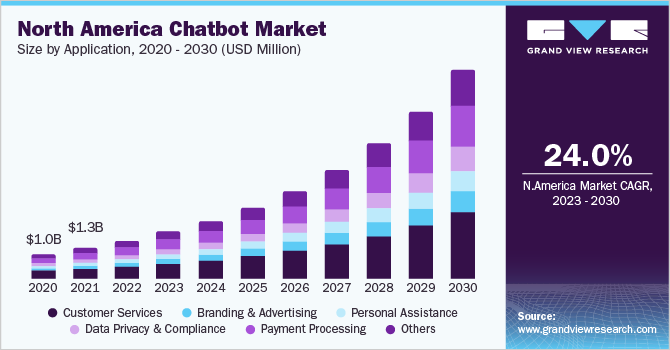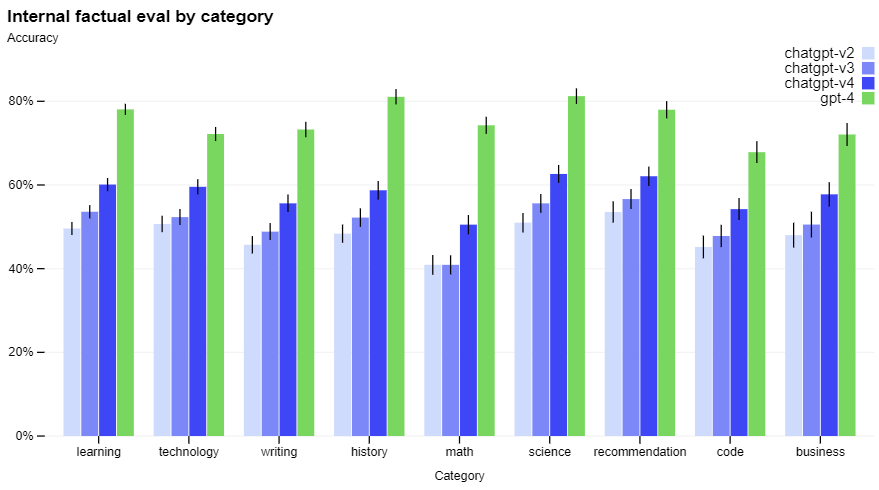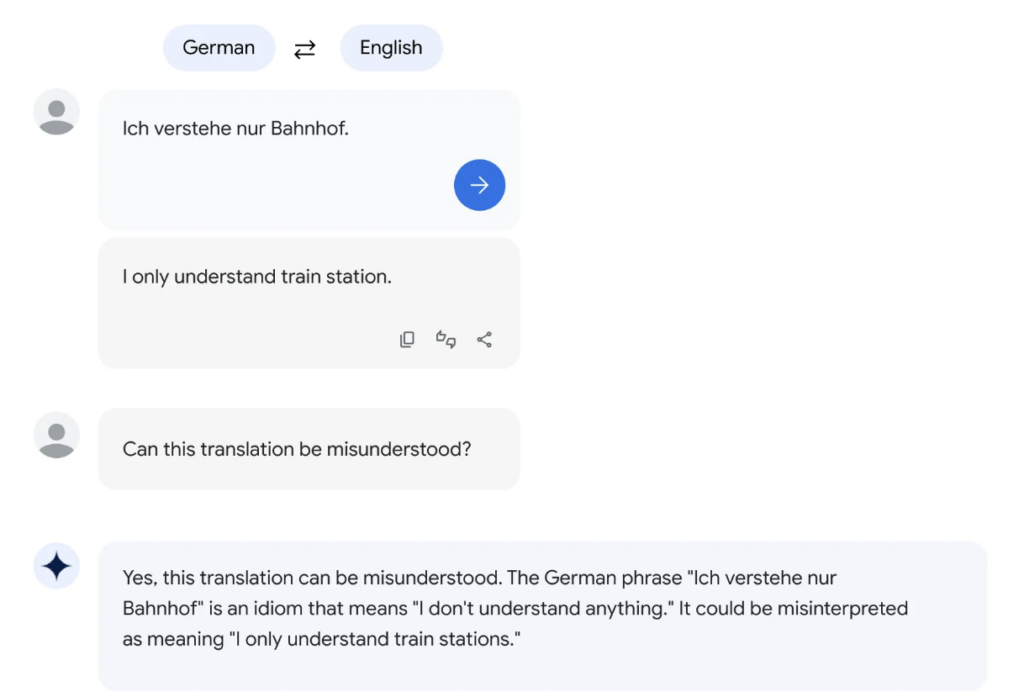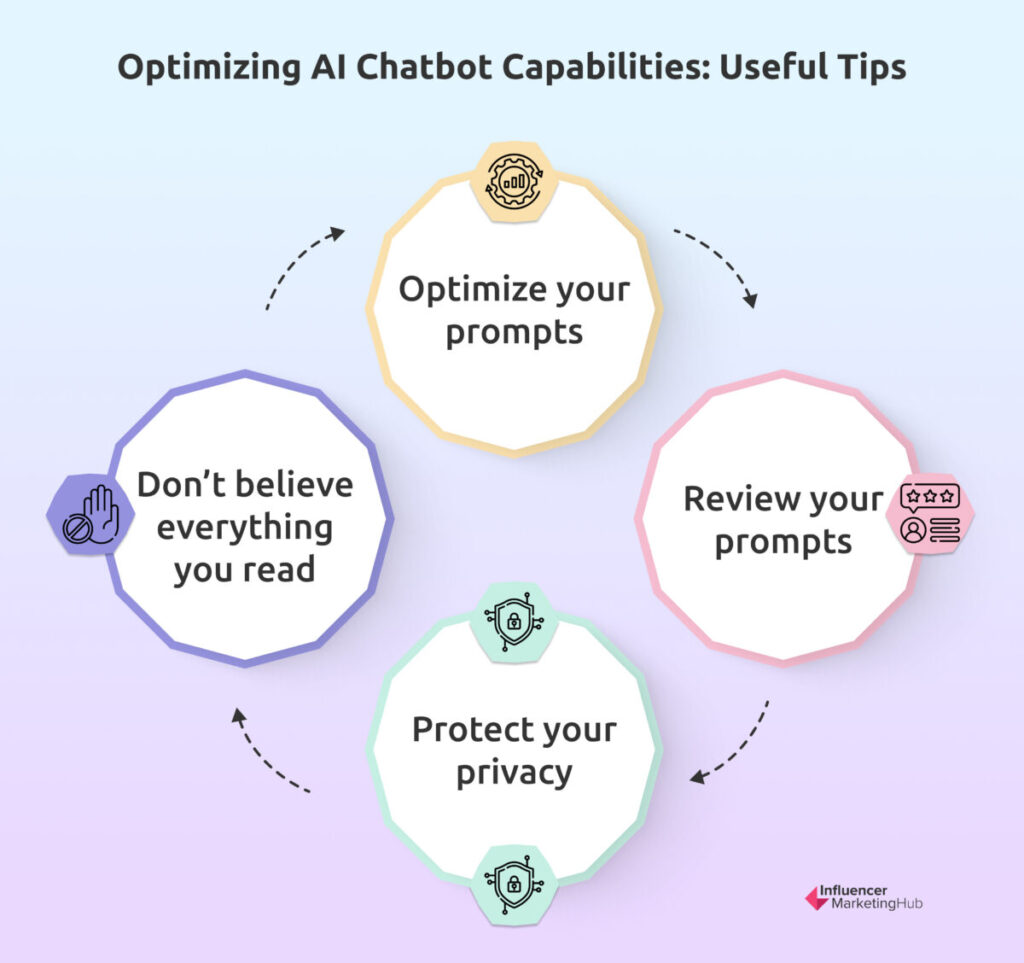Need to write that dreaded email? Or can’t seem to find the right code for your project? Chances are, you’ve used an AI chatbot to help you brainstorm ideas or jumpstart a concept. AI chatbots like ChatGPT and Google Bard have become immensely popular these days. It’s projected that by 2030, the market will have a revenue of nearly USD 28 billion.

Source: grandviewresearch.com
One of the main factors contributing to the market’s growth is the growing use of AI chatbots by businesses to cater to their customers’ needs. Automation in customer service and the use of chatbots in marketing have also contributed to the industry’s rapid growth.
In this article, we’ll look into two of the most popular conversational AI chatbots today: ChatGPT and Bard. We’ll dive into how each one works, what their use cases and applications are, and what their limitations are.
A Quick Guide to Understanding ChatGPT and Bard and How These AI Chatbots Work:
Understanding ChatGPT and Google Bard
If you’re frequently online or visiting different websites, you’ve likely come across chatbots. Now, regular chatbots, like the ones you see on eCommerce websites, are different from AI chatbots in several ways. Traditional chatbots operate on pre-determined responses, while conversational AI chatbots are capable of “learning” from your conversations. This means that AI chatbots like ChatGPT and Bard can understand the context of your conversation—and to some extent, your emotions and intents—and can respond in a more conversational or natural manner. Furthermore, since AI chatbots use large language models and are trained on a large variety of datasets, they can be used to solve problems and perform tasks like gathering information.
Conversational AI technology uses machine learning and natural language processing (NLP). The former allows a conversational AI chatbot to “learn” from human feedback or prompts, allowing it to get better the more it’s used. That’s because AI chatbots collect information from interactions and they use these interactions to improve their responses.
Meanwhile, NLP allows AI chatbots to understand language. This capability allows an AI chatbot to recognize the words you use in your prompts and generate responses in natural language. So if someone types in a prompt asking an AI chatbot for birthday ideas for toddlers, it uses data from previous interactions and similar prompts to understand your prompt and generate an appropriate response.
There are also several benefits to using conversational AI chatbots. They can save you time and improve productivity. For businesses, conversational AI chatbots can help provide better customer experiences through the use of data-driven insights.
ChatGPT
Developed by OpenAI, ChatGPT is a conversational AI chatbot that uses GPT language models. These allow ChatGPT to perform multiple tasks, depending on your prompt. For instance, you can use it to explain a certain concept, brainstorm ideas, or simply have a conversation. ChatGPT currently uses two GPT models: GPT-3.5 and GPT-4. The former is free to use but is less powerful. The latter is a large multimodal model only available to ChatGPT Plus subscribers and is more advanced than GPT-3.5. It’s also more accurate, has advanced reasoning capabilities, and can solve more complex problems. Furthermore, GPT-4 is capable of accepting both visual and textual prompts. GPT-4 is considered safer and is 82% less likely to respond to prompts or requests for disallowed content. It’s also 40% more likely to generate factual responses compared to older GPT models.

Source: openai.com
While GPT-4 is the more advanced of the two language models, they do share similar limitations. According to OpenAI, these language models can “hallucinate” and aren’t impervious to making reasoning errors. However, given that GPT-4 is more advanced than previous models, it’s able to reduce these hallucinations.
Bard
Google introduced Bard in February 2023 and started providing access to it in March 2023. While it functions similarly to ChatGPT, Bard is capable of collecting information from the web via Google. Previous Bard iterations used an older large language model (LLM), LaMDA, because it’s lightweight and required less computing power. Bard now uses Google’s latest LLM called PaLM 2. PaLM 2 was trained in 20 programming languages, including Python, JavaScript, and Fortran.
Moreover, PaLM 2 models are trained on multilingual text covering over 100 languages, and they have more powerful logic and reasoning capabilities compared to older language models. Aside from Bard, PaLM 2 is also used to power over 25 Google products. These include Google Workspace and Med-PaLM 2, which can analyze medical texts.

Source: ai.google
When you enter a prompt, Bard gives you three drafts, allowing you to choose from three different answers. It also has a regular search feature, via the “Google it” button, allowing you to search related topics. After writing a prompt and getting a response, you’ll see some buttons at the end of the response, aside from the “Google it” button. These let you indicate if the response was a good one or a bad one, modify the response to make it shorter, longer, or more casual, or share and export the response.
Bard has recently been updated. Updates include a Google Lens integration, which lets you upload images alongside your text prompts, text-to-speech capabilities in over 40 languages, and the ability to pin your recent conversations with Bard.
Core Differences Between ChatGPT and Google Bard
While both ChatGPT and Google Bard are powerful AI chatbots that interpret text prompts, they differ primarily in several key areas. Bard leverages information from the internet, allowing it to interpret and provide users with the latest data. Bard was also trained on conversations and dialogues sourced from the web.
Meanwhile, ChatGPT’s sources are up to 2021 only, which means the data is limited to some extent. While ChatGPT is pre-trained using massive datasets from sources like Wikipedia and Common Crawl, it is only capable of utilizing scraped general content.
They also utilize different language models. Bard uses PaLM 2, Google’s large language model that’s capable of reasoning, multilingual translation, and coding. According to Google, PaLM 2 was pre-trained using a variety of datasets, which include data from webpages and source codes, scientific papers, and parallel multilingual text. ChatGPT uses the GPT-3.5 (GPT-4 for the ChatGPT Plus) large language model and is also trained on human feedback, which provides it with reinforcement learning (Reinforcement Learning from Human Feedback or RLHF). RHLF helps fine-tune ChatGPT through supervised fine-tuning, proximal policy optimization, and mimicking human preferences.
Bard is capable of supporting over 40 languages, while ChatGPT can support over 95 languages. Aside from these key differences, ChatGPT and Bard also differ in some areas. For instance, Bard is capable of accessing the web in real time, whereas ChatGPT can’t. Moreover, ChatGPT is capable of learning from conversations and holding context, while Bard is currently limited in its conversational learning capabilities.
Use Cases and Applications
Both conversational AI chatbots have diverse applications and use cases. Note that both AI chatbots are still under development, so it’s best not to expect perfect results. The good news is that both platforms are constantly learning and getting better.
Furthermore, both ChatGPT and Bard can be used for different use cases, especially since they’re both powerful conversational AI chatbots. Given that both ChatGPT and Bard are continuously being developed, we’ll likely see more potential use cases for them in the future. For now, we’ll outline some of the main use cases and applications for each one.
ChatGPT
You can use ChatGPT for the following:
- Writing and debugging code
- Documenting code
- Translating or learning a new language
- Automating customer service responses
- Generating content like blog posts or social media posts
- Generating leads and sales
- Brainstorming ideas for content creation
- Drafting your content
- Writing lyrics
- Creating narratives for stories and games
- Generating custom responses to queries
- Writing or drafting emails
Bard
- Transcribing letters to digital text
- Searching for online deals
- Generating code
- Generating ideas for a trip or a meal plan
- Finding information online
- Creating content like blog posts, scripts, emails, and letters
- Creative writing
- Researching by finding information on the internet
- Creating interactive learning experiences
- Providing customer support
- Scheduling appointments
Limitations and Challenges
AI chatbots may seem like the ultimate solution for a wide range of tasks. However, while both are powerful solutions, they still do have some limitations. Both AI chatbots are prone to hallucinations, wherein they make stuff up and pass it off as factual. This can be a problem if you’re looking for accurate or factual information. ChatGPT and Bard may also generate erroneous results. That’s because they’re both limited by the data they’re trained on. On the Bard website, there’s even a disclaimer stating that “Bard may display inaccurate or offensive information…”

Source: bard.google.com
And while both are capable of understanding the context of your text or image prompts, their contextual understanding isn’t as complex as that of humans. For instance, they may miss cultural contexts, leading them to generate inappropriate responses. Moreover, they may still be prone to biases, given that they use a wide variety of datasets for training. Some of these datasets may have biases. While both OpenAI and Google are working toward making their AI chatbots safer for all users, this is still a challenge that’s worth looking into and addressing.
There’s also the issue of privacy. In the case of Bard, human review of conversations, feedback, and related data is required to help improve the AI chatbot’s performance. However, according to Google, certain steps are being taken to protect users’ privacy. For instance, your conversations with Bard are disconnected from your Google account before they’re seen by human reviewers.
Meanwhile, OpenAI’s privacy policy states that ChatGPT collects different sets of data, including log data, usage data, and user content. This has become a problem in countries like Italy, which temporarily banned access to the generative text tool in March 2023. However, the ban was lifted in April 2023, following the implementation of changes needed to address the privacy-related issues raised by the Italian Data Protection Authority. On April 2023, OpenAI also introduced a feature that lets users better manage their data in ChatGPT, which allowed them to turn off their chat history.
However, there’s still the risk of ChatGPT being used by bad actors to generate fraudulent services, disclose private data, and generate malicious code. According to the study, ChatGPT can be used by malicious actors to gather information on selected targets. It can also be used to generate malicious text for phishing campaigns, disinformation, and impersonation.
Recommendations
If you want to maximize the capabilities of AI chatbots, then here are some tips to help you out:

- Optimize your prompts. Text prompts are how users communicate with AT chatbots. These prompts also enable machine learning models to generate results. The more optimized or specific your prompts are, the more likely you’ll get better results from Bard or ChatGPT. There are several ways to optimize your AI prompts. For example, you can try to be more descriptive. Instead of writing “Write song lyrics about love”, you can instead write something like “Write song lyrics about love in the style of Jay-Z”. You can also provide added context in your prompts. If you want an AI chatbot to generate a poem, for example, you can provide it with more information like the style you’re going after or what you want the poem to be about.
- Review your prompts. To get better results, try to test out different variations of a certain prompt until you get your desired outcome.
- Remember to protect your privacy. Your prompts may be used to train ChatGPT’s or Bard’s language models. While some service providers do offer measures to protect your privacy, it’s crucial that you refrain from sharing personal data.
- Don’t believe everything you read. AI chatbots are still prone to hallucinations and biases, so you must review the responses generated by Bard or ChatGPT.
Final Verdict
There’s no denying the fact that both ChatGPT and Bard are powerful AI chatbots that have the potential to change the way we approach generative AI technology. As such, there’s no clear answer to the question of which AI chatbot is better. Your choice will ultimately depend on what your needs are. For example, if you want to access more recent information from the web in real time or if you need a solution that integrates well with Google Workspace, then Bard is the better option. If you want answers to open-ended questions or you need help with generative creative content, then ChatGPT will most likely be more helpful.
It’s worth noting that since the field of generative text tools is relatively new, the AI chatbots you now see are still works in progress. Thus, they may still be prone to errors. Moreover, new risks, as well as opportunities, may crop up as new models continue to be developed.
Frequently Asked Questions
Can I use ChatGPT and Bard for free?
Yes. To start using ChatGPT, you need to create an account on the OpenAI website. To use Bard for free, you need to have a Google account.
Are the responses generated by AI chatbots accurate or reliable?
While both AI chatbots are trained on large amounts of data, they can still hallucinate. This means that they can fabricate information and pass it off as factual. It’s always best to fact-check the results and take everything generated by these AI chatbots with a grain of salt.
How do I make an optimized prompt?
There are many ways to optimize your AI chatbot prompts, aside from providing context and being more descriptive. You can structure your prompts in such a way that it tells the AI chatbot to do a certain action first. For example, you can tell it to read a research paper first and then create a summary based on that paper. Also, feel free to tweak your prompts until you get the answer you want.
lamhoangmedia.com | 2023-12-13 08:26:01 – influencermarketinghub.com
